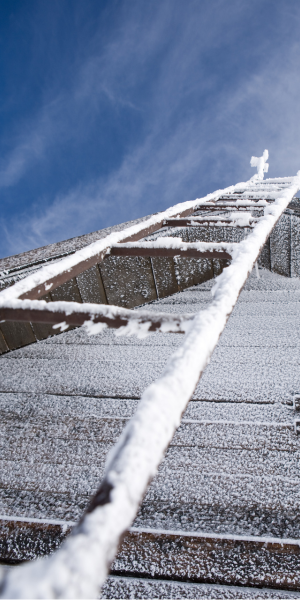Winter in Britain is generally marked by its chilly temperatures, damp air, and often unpredictable weather patterns. While the cold is rarely extreme, it can be tough on construction sites, with cold temperatures, snow, ice, and reduced daylight hours all impacting project timelines, site safety, and product performance.
We have put together some key tips and best practices to help your site operate smoothly and safely through the colder months.
Cement-Based Products
When working with cement-based products, be sure to understand how the product’s early strength development is affected by temperature. So, when it’s cold, the concrete / mortar needs to be protected until it can handle the cold on its own. The general rule is that once the concrete has gained strength to about 5N/mm² (5Mpa) then it’s OK.
When the concrete achieves 5N/mm² compressive strength, hydration of the cement has consumed enough of the water in the original mix so that even if it does freeze, there’s not enough water left in the pores to damage the product. With most cement-based products, even at 10°C, this happens during the second day. So, at the very least, concrete must be protected for at least 24 hours and preferably 48 hours. Unless you are using a fast set product in which case this could be a matter of hours.

Resin Products
Products such as epoxy resin-based or polyester-based mortars and grouts are affected by cold weather. Most epoxy resins become dormant below 5°C and setting will be very slow, if at all, until the temperature increases.
Below 0°C, the mixed epoxy-hardener system can also irreversible disrupt the integrity as the catalyst is usually affected by the cold and can crystallise.
Polyester resins in general can stand the cold a little better, but they too will set much more slowly at 0°C.
Manufacturers produce materials that can be used in cold weather as long as certain procedures are implemented by users. It is up to the end user to ensure that these processes are strictly followed. For example, rbs Epoxy Mortar Cold Cure, is specially formulated for use at temperatures down to 2°C.
Mixing
It is a common fallacy to mix cement and aggregates with warm water and expect the concrete mix to warm up in the process. It is the powder that governs the temperature of the mixed material, not the water. The heat capacity of the powder and its relatively larger volume compared to that of water is the governing factor. Hence storing product in warm environments is crucial.
So remember: Warm water & warm product.
The same principle holds for resin products, always keep the components warm.
Storage
The bags of concrete, mortar or tins of resin should be stored in a warm dry environment, off the ground. Temperature of storage plays a major role in keeping the materials from freezing in cold weather, as will be explained later.
Warm up the products to about 20°C for 24 hours prior to application.
Substrates
On no account should mortar, concrete or resins be placed on frozen concrete or adjacent to cold steel. Provide heating to raise the temperature of the substrate concrete, steel etc to above 5°C, preferably 10°C for 24 hours prior to application.
The use of tenting and heating is an accepted process. In many cold locations such as Canada and Scandinavia this is common place to keep contracts running in the winter.
Curing
Temperatures must be maintained ideally above 10°C for at least 24 hours if not 48 hours. This depends on the ambient temperature. The continued use of the tenting and heating system is a common practice but the use of insulated blankets or heated blankets is better recommended as this method does not dry out the concrete surface and lead to plastic shrinkage.
This procedure holds well for both cement and resin materials used in cold weather.
Using Cold Weather Ready Products
Some construction materials are particularly vulnerable to freezing temperatures, moisture, and thermal expansion. Using the right products for winter work can save both time and money in the long run. Here are some materials to consider:
Cold Weather Concrete Mixes
Regular concrete can be susceptible to freezing, which affects curing times and can reduce structural integrity. When mixing concrete in cold weather, building admixtures such as Sika Wintermix chloride free liquid admixture can accelerate curing time and reduce the chance of freeze damage.
Sika Wintermix
Wintermix is an air entraining chloride free liquid admixture for mortar and concrete which also acts as an accelerator for work in sub-zero temperatures. Improves workability and freeze/thaw resistance in brick laying mortars and eliminates the need for a separate frostproofer. Provides resistance to freeze/thaw cycling down to -8 °C in both wet and dry mortar. Faster finishing times even in cold weather
Fosroc Resivit
A liquid admixture which is added to mortars and concrete during production in order to accelerate their setting and hardening to quickly attain increased merchanical resistance. Particularly effective in assisting to offset the delaying effect of low temperatures on setting and strength gain. Accelerated setting reduces the risk of damage to fresh concrete from freezing. Chloride free, safe for use in reinforced concrete.
Cold-Weather Mortar and Grout
Specialty mortars and grouts are formulated to work in lower temperatures. The key is to avoid adding extra water to make the mix easier to work with, as this can lead to problems in freezing conditions.
Flexcrete Fastfill
Flexcrete Fastfill is a single component, polymer modified, fibre reinforced Portland cement based repair mortar. A rapid curing mortar with enhanced polymeric properties and reliable strength development, which is not significantly affected by low temperature use. Can be used as supplied up to 100mm deep, or bulked out with sharp sand or aggregate to a flowing consistency for floor or deck repairs up to a maximum depth of 300mm. Rapid strength development at sub-zero temperatures.
Natcem 35
NATCEM 35 is an environmentally friendly, fast setting mortar with rapid strength gain, suitable for installation up to any thickness from a minimum of 10mm.
The product consists of a blend of Natural Cement binder, retarder and specially selected graded aggregates all passing a 2mm sieve. Can be used down to 0°C.
Weather Resistant Sealants & Adhesives
Many adhesives become brittle or lose their bonding properties in the cold. Choose products specifically labelled for cold-weather application to ensure secure, lasting bond such as Sika Stixall Extreme.
Sika Stixall Extreme
Stixall Extreme one part, chemically curing solvent free sealant and adhesive combining the best qualities of silicone and polyurethane technologies. It is specifically designed for adhering most common building surfaces to each other and themselves. Resistant to temperature extremes -40°C to +100°C. Suitable for sealing and bonding in almost every application imaginable.
Illbruck FM330
A one part, moisture curing expanding, gun applied, polyurethane foam. Ideal as an air tight gap filler for general construction joints including where movement is expected to occur. Excellent adhesion to brick, block, stone, plaster and cementitious materials as well as wood, metal and a variety of plastics. The sub-zero formulation means is can still be used at temperatures as low as -3°C.
Protect Equipment and Tools in Winter
Cold weather can affect the performance of machinery and tools, leading to potential breakdowns or unsafe conditions. Here’s how to prepare:
- Pre-Inspect Equipment Daily: Low temperatures can reduce battery life and oil viscosity, impacting machinery performance. Check batteries, fuel levels, oil, and antifreeze daily to prevent unexpected downtime.
- Store Tools Properly: Moisture and frost can quickly rust or degrade metal tools. Store tools and smaller equipment in under insulated covers to protect them from snow, ice, and moisture or in warm conditions.
- Use Heaters and Dehumidifiers on Site: Portable heaters and dehumidifiers help reduce moisture, which can prevent tool corrosion and make for safer, ice-free work areas.
Winter Safety Precautions
Cold temperatures, shorter days, and slippery conditions mean safety measures must be adapted for winter. Keep your crew protected and your site safe with these best practices:

- Protect Against Slips and Falls: Ice and snow are a leading cause of slips on construction sites. Regularly clear walkways, lay down anti-slip mats or sand. Also, ensure scaffolding and ladders are free from ice.
- Increase Lighting for Shorter Days: Reduced daylight hours mean many workers are on-site in the dark. Additional lighting, such as portable LED towers, improves visibility and reduces the risk of accidents.
- Encourage Warm Clothing and Breaks: Encourage workers to dress in layers, wear insulated gloves, and take regular breaks in heated areas. Don’t forget Resapol’s winter beanie hats are available on request.
- Update Site Signage for Winter Hazards: Signs that indicate icy areas, snow build-up, or falling icicles are essential in high-traffic zones.
Managing Your Timeline
Winter weather can be unpredictable, so plan with flexibility. Snowstorms, heavy winds, or sub-zero days can delay progress, so build in extra time and be prepared to adapt.
- Monitor Weather Forecasts: Check the forecast daily and make quick adjustments to avoid unsafe working conditions. Set up automated notifications for severe weather so your team is always prepared.
- Adjust Work Schedules to Avoid Peak Cold Times: If possible, schedule tasks that require precision or outdoor work during the warmest parts of the day, typically late morning to early afternoon.
- Factor in Extra Time for Product Curing: Cold weather can slow down the curing process of concrete and other materials, so build these extended timelines into your schedule.

Team Training
Ensure your team is well-versed in winter-specific protocols, from handling materials in low temperatures to recognizing signs of cold stress.
- Conduct Winter Safety Meetings: Host regular safety talks to remind your team of cold-weather protocols and address any new hazards that arise with changing weather.
- Educate on Cold Stress Symptoms: Teach employees to recognize early signs of frostbite, hypothermia, and other cold-related conditions. Quick identification can prevent more severe issues.
- Implement Buddy Systems: Having a partner system allows workers to look out for each other and can be a helpful safety measure in cold, isolated conditions.
Summary
Winter construction can be challenging, but with thoughtful planning, the right products, and a safety-focused mindset, your site can continue to operate smoothly and safely, regardless of what winter throws your way. Embrace these tips to keep your team warm, your timeline on track, and your project moving forward through even the frostiest months.
Resapol are here to support you whatever the weather, with excellent technical advice and same / next day delivery on a large number of products. With our depots strategically situated across the UK, so shipping to you is both quick and efficient.
